| |
Oregon - the Beaver State |
| Click the points of the map below to learn more

|
| |
 |
Located on the confluence of the Columbia and Willamette rivers, Portland is the largest city in Oregon, the second largest city in the Pacific Northwest, and the 28th largest city in America.
The city of Portland was named after Portland, Maine, the hometown of one of the city’s co-founders, Francis W. Pettygrove. According to legend, Pettygrove, from Portland, Maine, and his co-founder, Asa Lovejoy, from Boston, both wanted to name the new settlement after their hometowns. Pettygrove won a coin flip, and the settlement was named Portland. The coin used in the flip, known as the "Portland Penny," is currently on display at the headquarters of the Oregon Historical Society. In its early days, Portland was known as "Stumptown" because of the many trees felled to make space for the settlement. The city started to grow in the late 1830s as more and more emigrants came to Oregon City via the Oregon Trail.
Today, Portland is known as the "City of Roses" and is home to the International Rose Test Garden. The garden features over 7,000 rose plants from 550 different varieties of roses. Despite its northerly latitude, Portland rarely receives snow in the winter, but rather, copious amounts of rain. Summers are hot, sunny, and dry. Portland is home to the NBA’s Trailblazers as well as apparel companies Nike.
Back to Map
|
| |
|
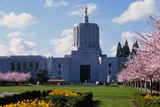 |
Salem
Located within the Willamette Valley, Salem is the capital of and third largest city in Oregon. Salem is known as the "Cherry City" because of the historical importance of the cherry industry in the region. Salem was founded in 1840 by missionary Jason Lee. Lee promptly established the Oregon Institute, which later became Willamette University, the oldest university in Oregon. Although Oregon City was the original capital of Oregon, it was moved to Salem in 1851.
Back to Map |
| |
|
 |
Eugene
Located within the Willamette Valley, Eugene is the second largest city in Oregon. Eugene, Oregon was founded in 1862 by Eugene Skinner as a post where ferries could cross the Willamette River. In 1876, the University of Oregon was established in Eugene.
Today Eugene is home to the Oregon Air and Space Museum, the Conger Street Clock Museum, and the Knight Library, the largest library in Oregon.
Back to Map |
| |
|
 |
Bend
The fast-growing city of Bend is named after "Farewell Bend," one of the few fordable locations on the Deschutes River. The city of Bend was not founded until the early 1900's when Alexander M. Drake built the Pilot Butte Development Company on the "bend" of the river. Bend, which actually enjoys a desert climate, has a thriving tourist economy. Visitors from throughout the country come to Bend for its excellent skiing opportunities and outdoor
activities.
Back to Map |
| |
|
 |
Klamath Falls
Klamath Falls is a small city located in southern Oregon.
Founded in 1867 by George Nurse, the town was originally
called Linkville because of its location along the Link River.
Klamath Falls was quickly settled during the era of west-
ward expansion and became a center of the timber industry.
In 1909, the Southern Pacific Railroad came to Klamath Falls, helping to make it the fastest growing city in Oregon. Unfortunately the timber industry collapsed after the Great Depression, and Klamath Falls has suffered ever since.
Back to Map |
| |
|
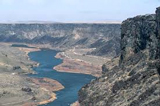 |
Snake River
| Length: |
1038 miles |
| Source: |
Continental Divide at Yellowstone National Park, WY |
| Outflow: |
Columbia River |
| |
|
The Snake River has long been a symbol of the wild north-
west. It is the largest tributary of the Columbia River and was first documented during the Lewis and Clark expedition of 1803-1806. It was named for its winding snake-like path, which carves through parts of Wyoming, Idaho, Washington and Oregon. |
Back to Map |
| |
|
 |
Columbia River
Beginning in British Columbia, the mighty Columbia River
flows through Washington State and forms the border between that state and Oregon. It then flows west, merging with the Willamette River, before flowing into the Pacific Ocean.
The Columbia River is the largest river (in volume) flowing
into the Pacific Ocean from the Western Hemisphere. It is the largest hydroelectric power producing river in North America.
| Length: |
1232 miles |
| Source: |
Columbia Lake (British Columbia, Canada) |
| Outflow: |
Pacific Ocean |
| |
|
Back to Map |
| |
|
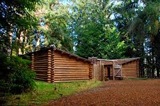 |
Fort Clatsop
Fort Clatsop was the winter encampment of Meriwether
Lewis, William Clark, and the Corps of Discovery during the winter of 1805-1806 at the mouth of the Columbia River. It was named after the Clatsop Indians that inhabited the area. Fort Clatsop marked the westernmost point explored by Lewis and Clark during their landmark expedition into western lands acquired by the United States in the Louisiana Purchase. The original structure was little more than a small, cramped, wooden hut.
Back to Map |
| |
|
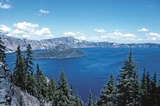 |
Crater Lake
Crater Lake National Park , located in southern Oregon, is famous for its deep blue color and spectacular scenery. The lake itself sits atop a 6 mile wide caldera that was formed some 7,000 years ago by the eruption and collapse of Mt. Mazama. The lake is rimmed with beautiful forests of fir, hemlock, and pine. Crater Lake (1,932 feet) is America's deepest lake, and second deepest in North America. Crater Lake National Park averages over 533 inches of snow in the winter.
Back to Map |
| |
|
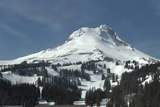 |
Mt. Hood
Mount Hood, part of the Mount Hood National Forest in northern Oregon, is the highest mountain in Oregon and the fourth highest in the Cascades Range. It is actually a dormant volcano that last erupted in 1782. Mount Hood was named by Lt. William Broughton on October 29, 1792. It was named after British admiral Samuel Hood.
Back to Map |
| |
|
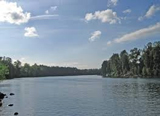 |
Willamette River
The Willamette River and its tributaries form the Willamette Valley, one of the most fertile agricultural regions in all of North America. The Willamette Valley was the top destination for immigrants traveling along the Oregon Trail.
Unfortunately, parts of the Willamette River are heavily polluted from years of industrial development. In 2005, the Environmental Protection Agency began a massive effort to clean the river.
| Length: |
240 miles |
| Source: |
Various forks in the Cascades Range |
| Outflow: |
Columbia River |
| |
|
Back to Map |
| |
|
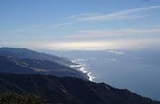 |
Coast Range
The Coast Range is the westernmost range of a series of ranges that run along the west coast of North America known as the Pacific Cordillera.
| Length: 2,300 miles |
| Highest Point: Mt. Logan (Canada) 19,850 ft. |
| |
Back to Map
|
| |
|
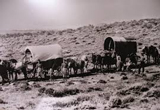 |
Oregon Trail
The Oregon Trail was a legendary migration route that brought settlers from Missouri to Oregon during the era of westward expansion in the 1800's. The trail spanned over 2,170 miles through Missouri, Kansas, Nebraska, Wyoming, Idaho and Oregon. Settlers were offered free land (until 1854) in Oregon's Willamette Valley for making the brutal journey on their prairie schooners. The trail was used until 1869 when the Transcontinental Railroad opened.
Back to Map |
| |
|
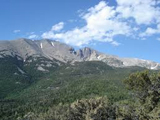 |
Great Basin
Encompassing the entire state of Nevada, and much of Utah, Idaho, and Oregon, the Great Basin is an arid, mountainous area in the western United States, between the Rocky Mountains and the Sierra Nevada Range.
It consists of a series of mountain ranges in Nevada including the East Humboldt, Ruby, and White Mountains. The basin itself is a series of watersheds with no outlet to the sea or to a river that flows to the sea. Any precipitation that falls evaporates, seeps into the ground, or forms playas, short lived lakes that eventually evaporate.
Back to Map |
| |
|
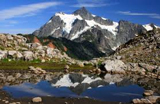 |
Cascades Range
The Beautiful Cascades Range dominates parts of Oregon and Washington state.
Length:
|
Apx. 700 miles |
| Highest Point: |
Mt. Rainier (WA) 14,411 ft |
| |
|
Back to Map |
|
| |
| Oregon State Bird |
| |
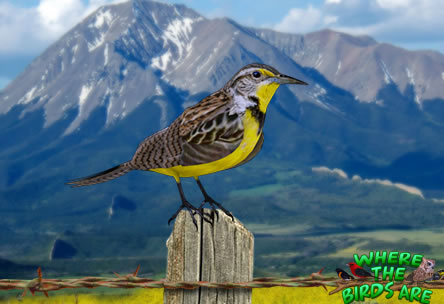
Oregon State Bird: Western Meadowlark |
| |
| Top Five Facts |
| |
1. ) Oregon's Crater Lake is the deepest lake in the United States. |
2. ) The Nike Corporation is headquartered in Beaverton, Oregon. |
3. ) The Simpsons, America's longest running sitcom, is situated in Springfield, Oregon. For many years, viewers knew the show took place in Springfield, but the actual state was a mystery. |
4. ) Portland, Oregon's largest city, was named after Francis Pettygrove, one of the city's founders, won a coin flip. He decided to name the city after his hometown of Portland, Maine. The pnny that was flipped is known as the Portland Penny, and is displayed in a local museum. |
5. ) Eugene, Oregon, was the first city in America to have one-way streets. |
| |
| Oregon in History |
| |
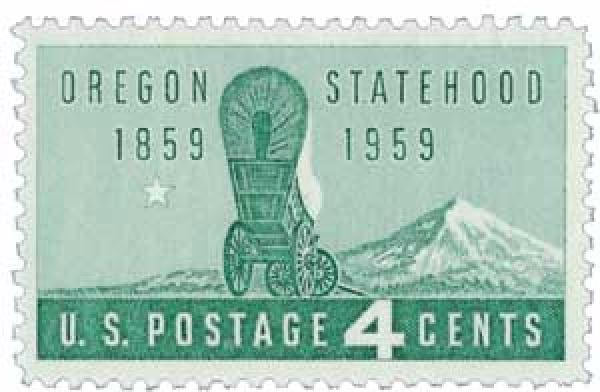
1543 - 1792: British and Spanish explorers came and settled looking for the “great river of the west” and to trade fur with the Indians.
1792: Captain Robert Gray found and named the Columbia River.
1804 -1805: Lewis and Clark, sent by Thomas Jefferson to explore the Louisiana Purchase and find a northwest passage to the Pacific Ocean, built Fort Clatsop on the Columbia River. They sent word that there were many fur-bearing animals.
1810-1812: The Astor Expedition, funded by millionaire John Jacob Astor, brought fur traders to modern-day Astoria on the Columbia River. It became the first "White" settlement in the region.
1842-1843: Thousands of people arrived in Oregon's Willamette Valley using the Oregon Trail.
1846: The Oregon Treaty settled a major boundary dispute between The United States and Great Britain.
1848: Oregon was established as a territory.
1859: Oregon became the 33rd state in the United States.
1873: The “great fire” in the city of Portland, Oregon, destroys most of town and costs the city $1,250,300.
1933-1937: Industrial development increases with the building of the Bonneville Dam on the Columbia River.
1942: In June of 1942, a Japanese submarine launched shells on Fort Stevens in Oregon. This was the only attack on the United States mainland during World War II. The submarine surfaced near the entrance of the Columbia River from the Pacific Ocean. The only damage they did was to a baseball field's backstop.
1966: The Astoria-Megler Bridge, was finished and stretched 4.1 miles from Astoria, Oregon, to Point Ellice, Washington. The bridge is 1,232 feet in length, the worlds 2nd longest "continuous truss" bridge. 1991: Mrs. Barbara Roberts becomes the first woman governor of Oregon. |
|
|

















